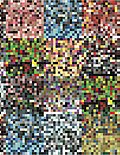Pixel
Pixel
A pixel (short for picture element) is the smallest unit of a digital image or graphic display that can be controlled. Pixels are combined to form a complete image, video, text, or any visible thing on a computer display or other display device.
Definition[edit]
The term pixel is a portmanteau of pix (from pictures) and el (for element). Each pixel is a sample of an original image, where more samples typically provide a more accurate representation of the original. The intensity of each pixel is variable; in color systems, each pixel has typically three or four components such as red, green, and blue, or sometimes red, green, blue, and alpha (transparency).
Resolution[edit]
The measure of how many pixels are present in a given digital image is known as its resolution. The higher the resolution, the more pixels there are in an image, and thus more visual information it contains. Resolution can be defined in various ways, including pixel count, pixel density, pixels per inch (PPI), and others.
Pixel in Computer Graphics[edit]
In computer graphics, pixels encoding the color information are used to create a raster image. A raster image is a data structure representing a generally rectangular grid of pixels, or points of color, viewable via a monitor, paper, or other display medium.
Pixel in Digital Photography[edit]
In digital photography, a pixel is a physical point in a raster image, or the smallest, addressable element in a display device. The number of pixels in an image or display that make up the X and Y axes are often referred to as the resolution.
See also[edit]
-
Pixel
-
Closeup of pixels
-
Reconstructions from pixels
-
8 BIT Game People, Festival Internacional de Linguagem Eletrônica
-
ClearType example
-
Pixel geometry example
-
Samsung TV subpixels
-
Sensor resolutions
-
Megapixel comparison
Ad. Transform your life with W8MD's Budget GLP-1 injections from $75


W8MD offers a medical weight loss program to lose weight in Philadelphia. Our physician-supervised medical weight loss provides:
- Weight loss injections in NYC (generic and brand names):
- Zepbound / Mounjaro, Wegovy / Ozempic, Saxenda
- Most insurances accepted or discounted self-pay rates. We will obtain insurance prior authorizations if needed.
- Generic GLP1 weight loss injections from $75 for the starting dose.
- Also offer prescription weight loss medications including Phentermine, Qsymia, Diethylpropion, Contrave etc.
NYC weight loss doctor appointmentsNYC weight loss doctor appointments
Start your NYC weight loss journey today at our NYC medical weight loss and Philadelphia medical weight loss clinics.
- Call 718-946-5500 to lose weight in NYC or for medical weight loss in Philadelphia 215-676-2334.
- Tags:NYC medical weight loss, Philadelphia lose weight Zepbound NYC, Budget GLP1 weight loss injections, Wegovy Philadelphia, Wegovy NYC, Philadelphia medical weight loss, Brookly weight loss and Wegovy NYC
|
WikiMD's Wellness Encyclopedia |
| Let Food Be Thy Medicine Medicine Thy Food - Hippocrates |
Medical Disclaimer: WikiMD is not a substitute for professional medical advice. The information on WikiMD is provided as an information resource only, may be incorrect, outdated or misleading, and is not to be used or relied on for any diagnostic or treatment purposes. Please consult your health care provider before making any healthcare decisions or for guidance about a specific medical condition. WikiMD expressly disclaims responsibility, and shall have no liability, for any damages, loss, injury, or liability whatsoever suffered as a result of your reliance on the information contained in this site. By visiting this site you agree to the foregoing terms and conditions, which may from time to time be changed or supplemented by WikiMD. If you do not agree to the foregoing terms and conditions, you should not enter or use this site. See full disclaimer.
Credits:Most images are courtesy of Wikimedia commons, and templates, categories Wikipedia, licensed under CC BY SA or similar.
Translate this page: - East Asian
中文,
日本,
한국어,
South Asian
हिन्दी,
தமிழ்,
తెలుగు,
Urdu,
ಕನ್ನಡ,
Southeast Asian
Indonesian,
Vietnamese,
Thai,
မြန်မာဘာသာ,
বাংলা
European
español,
Deutsch,
français,
Greek,
português do Brasil,
polski,
română,
русский,
Nederlands,
norsk,
svenska,
suomi,
Italian
Middle Eastern & African
عربى,
Turkish,
Persian,
Hebrew,
Afrikaans,
isiZulu,
Kiswahili,
Other
Bulgarian,
Hungarian,
Czech,
Swedish,
മലയാളം,
मराठी,
ਪੰਜਾਬੀ,
ગુજરાતી,
Portuguese,
Ukrainian



